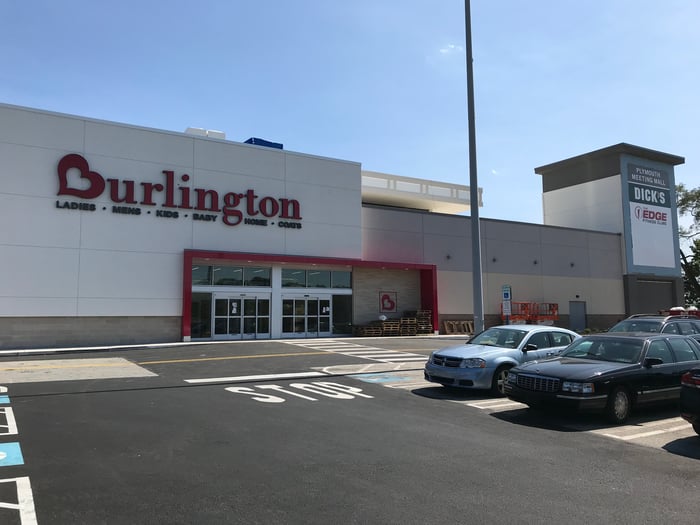The COVID-19 pandemic crushed sales at Burlington Stores (BURL 2.25%) last year. The pandemic's impact didn't last long for the No. 3 off-price retailer, though. Burlington returned to growth in the final quarter of fiscal 2020. Last week, the company reported that its growth rate accelerated dramatically in the first quarter of fiscal 2021, highlighting its massive long-term growth potential.
An incredible quarter
Burlington's sales reached $2.19 billion last quarter, up from around $800 million in last year's first quarter. More significantly, sales surged 35% compared to the first quarter of fiscal 2019, driven by a 20% comparable store sales gain and new store openings.
Notably, Burlington's Q1 sales performance easily outpaced the strong results of its closest rival, Ross Stores (ROST 0.02%). Ross Stores recorded a solid 19% increase in sales relative to the first quarter of fiscal 2019 on 13% comp sales growth.
The demand rebound that catalyzed Burlington's impressive sales results also enabled the company to improve its profitability. Gross margin expanded to 43.3% from 41% two years earlier. Meanwhile, operating expenses decreased as a percentage of sales because of the increase in store productivity. Together, these factors boosted the retailer's operating margin to 10.8% from 7.2% in Q1 2019.
As a result, Burlington's adjusted operating profit doubled to $238 million from $117 million in the first quarter of fiscal 2019. Adjusted earnings per share reached $2.59, triple the average analyst estimate of $0.83.

Image source: author.
A clear opportunity for revenue and earnings growth
Burlington CEO Michael O'Sullivan acknowledged that pent-up demand and the latest round of stimulus checks helped the company achieve its phenomenal sales growth last quarter. Growth could slow later this year as those tailwinds abate. Moreover, O'Sullivan warned investors that rising supply chain and freight costs could dent Burlington's profitability over the next few quarters.
Despite this near-term uncertainty, Burlington has incredible long-term sales and earnings growth potential. Earlier this year, management doubled its store count target. Burlington now expects to grow its nationwide footprint to 2,000 stores, up from 784 at the end of last quarter.
A new smaller-format store concept is the key to this growth plan. At the beginning of 2014, Burlington's average store size was 80,000 square feet. In recent years, it has closed or relocated many of those stores while opening new stores with roughly 40,000 to 45,000 square feet of space. This year, the company is opening even smaller stores, averaging around 32,000 square feet.
The shift to a smaller store prototype significantly increases Burlington's long-term store potential. It should also help the company secure better store locations. Those changes should allow it to improve its sales productivity. In recent years, best-in-class off-price retailers like Ross Stores -- which typically operate smaller stores -- have generated roughly double the sales per square foot of Burlington. Higher sales per square foot should in turn support margin expansion.
Is Burlington stock worth its premium valuation?
Burlington stock has already rallied well beyond its pre-pandemic high. Its market cap has reached $21 billion: roughly half that of Ross Stores, which generates about twice as much revenue. In other words, the two off-price retailers trade at nearly identical price-to-sales ratios. However, Burlington trades for more than 30 times forward earnings, compared to 23 times forward earnings for Ross.
Burlington vs. Ross Stores comparison, data by YCharts.
It's unusual for shares of a lower-margin retailer to trade at a premium to a best-in-class rival. Investors are betting that Burlington will continue to grow sales much faster than Ross Stores -- thanks to its smaller size today -- while eventually achieving a similar profit margin.
This isn't an outlandish scenario. Burlington Stores has a top-notch management team -- led by two Ross Stores veterans -- and it a clear plan to close the profitability gap relative to its larger rivals.
That said, Ross has plenty of room for growth, too. It plans to expand to at least 3,000 stores over time, up from fewer than 1,900 today. Meanwhile, it has far less execution risk. That makes Ross Stores look somewhat more attractive than Burlington at their current valuations.






